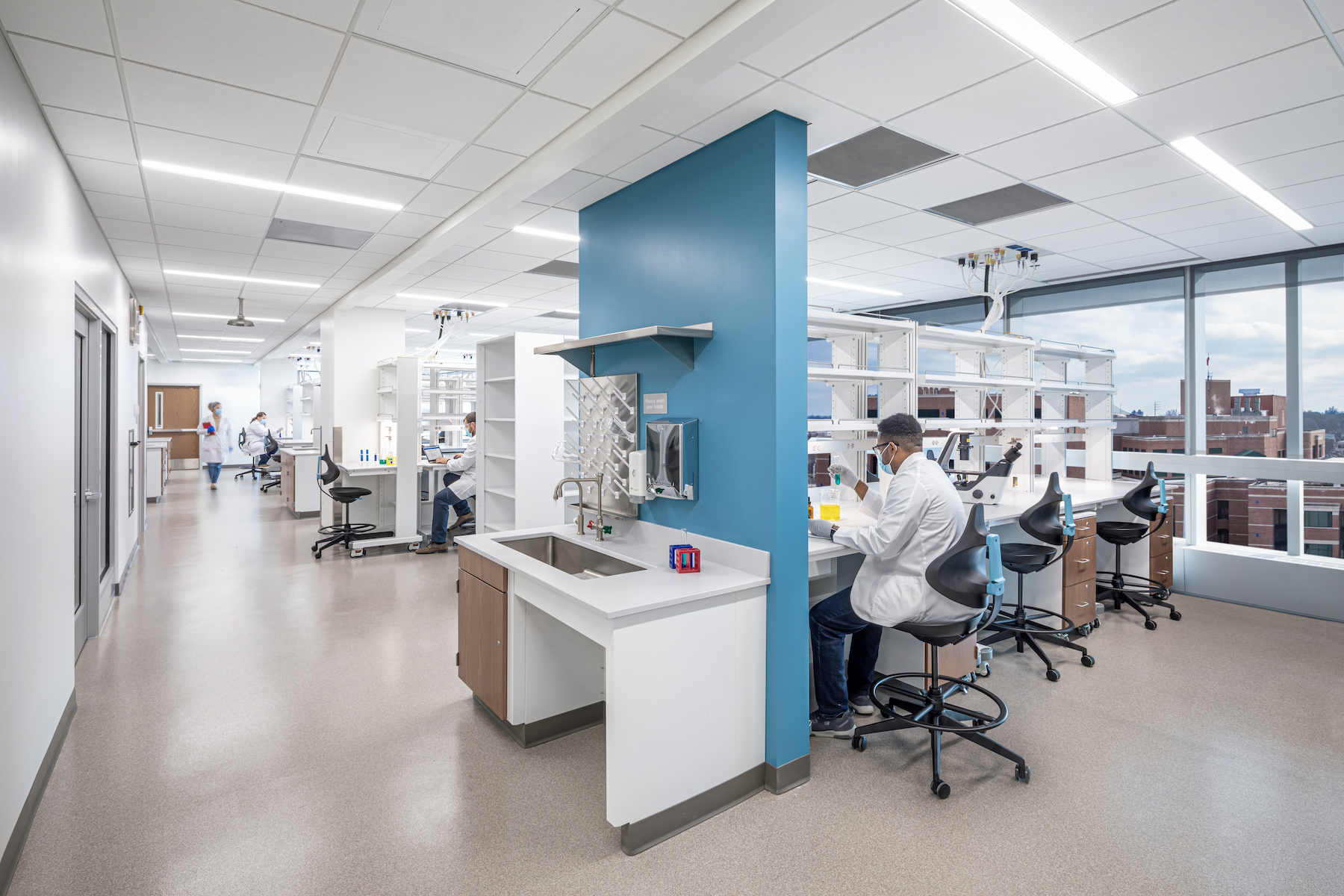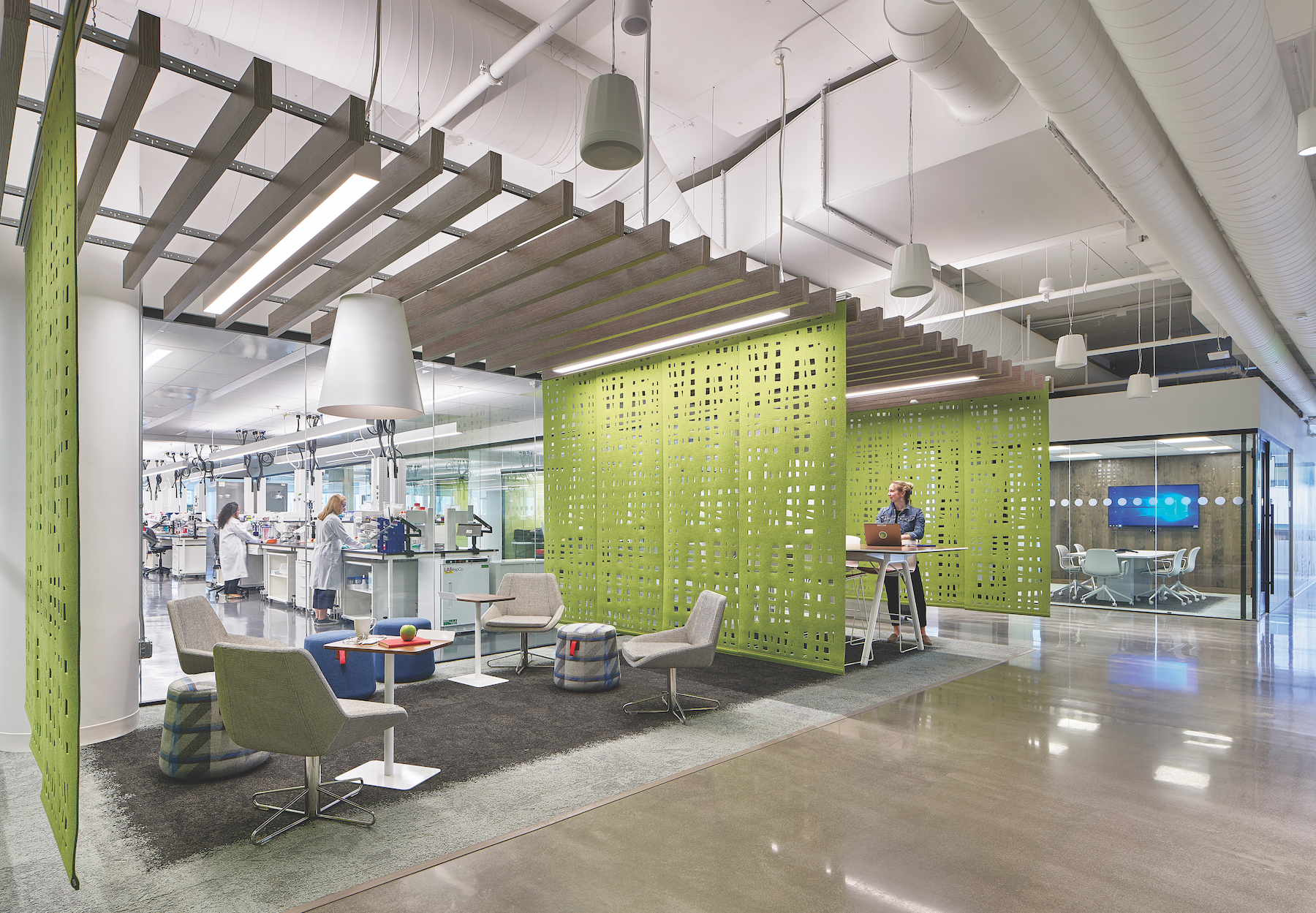Most AEC executives would probably agree with Greg Peele, Skanska’s Executive Vice President for operations in North Carolina and Virginia, who states that 2020 was a year “of remarkable growth and transformation” for the science and technology (S+T) sector.
The coronavirus pandemic triggered a private- and public-sector recommitment to bringing drug production back to the U.S. Firms like SmithGroup and Payette helped clients convert vacant or underutilized offices into life science spaces. The pandemic heightened the urgency for speed to market, especially among midstream pharma and personalized medicine/gene therapy focused clients, says Ed Cordes, Perkins and Will’s Global S+T Practice Leader. Cordes also points to a “doubling down” on research labs in clinical facilities.
The pandemic made virtual project design, coordination, and approvals more expedient and acceptable, say Vanderweil Engineers’ Managing Principals John Saad, LEED AP, and Chad Wisler, PE, LEED AP BD+C. But the health emergency also created delays in the overseas shipments of equipment and materials that can still impact the commissioning and validation processes. “It’s important to identify these critical items early in project procurement, evaluate alternative manufacturers where possible, and create flexibility with the schedule,” warns Brian Garbecki, Vice President with Gilbane Building Company.
RENOVATION, ADAPTIVE REUSE ASCENDING IN SCIENCE AND TECHNOLOGY BUILDING SECTOR
New construction still accounts for the bulk of S+T projects for AEC firms like Vanderweil, McCownGordon Construction, Jacobs, SmithGroup, and Payette.
However, Ellen Sisle, AIA, LEED AP BD+C, Jacobs’ Principal and Global Director of Science and Research, acknowledges that her firm’s ratio of new builds to renovations or adaptive reuse projects varies by location, with adaptive reuse being more prevalent in urban areas with a concentration of biotech, like Cambridge, Mass.
Joe Grosshart, President of Good & Roberts, a design-build affiliate of C.W. Driver Companies, notes that in Southern California, one of the country’s S+T hotbeds, 52% of life-science clients are choosing to repurpose existing buildings rather than build from the ground up. Good & Roberts recently completed a $4 million renovation project in San Diego for the medical device supplier NuVasive that converted a three-story building into a showroom and surgery suite; and a $2 million renovation of an existing 15,000-sf building for Cell Applications, which distributes cell cultures for medical research.
Developer and property manager The RMR Group (https://www.rmrgroup.com/Home/) redeveloped what had been the north campus of Scripps Research Institute for two decades into Muse, a 186,000-sf life sciences space whose three-building campus is owned by Diversified Healthcare Trust. The RMR Group manages this property and expected tenants to start occupying the building by mid-summer of this year.

“Functionality is most in demand for life science buildings that need to serve both R&D and business purposes, so providing a mix of modern lab facilities and flexible office space is crucial,” says Chris Bilotto, RMR’s Senior Vice President. Other in-demand features include connection to the outdoors, and food amenities.
Skanska anticipates an uptick in adaptive reuse for S+T projects, too, but this will vary by region and mostly depend on the relative availability of land. When it comes to design changes, Skanska has seen the greatest shifts among its higher ed clients. It recently completed labs for North Carolina State University, Duke University, and a private company in Durham, N.C. “Three different clients with three different designers, and in all three, we saw an increase in the size of the lab benches and the addition of cubicle dividers on the bench offices to support social distancing,” says Peele.
During renovations, it’s not uncommon for tenants’ employees to continue working in the building. AEC firms say they regularly confer with those workers about logistics. The firms also proactively seek occupant input about their projects’ parameters.
Communicating with people who will be using the building “is the heart and soul of our programming and planning,” says Jeffery Talka, AIA, LEED AP, Science + Technology Practice Leader for SLAM. He explains that end users establish area requirements, quality of space, engineering controls, equipment needs, cultural relationships, and safety measures.
“Good science is not just about coordinating utilities and meeting technical demands,” says P&W’s Cordes. “The right environments can attract and retain top talent, support collaboration and innovation, and help improve speed to market.”
The input from end users might be what’s spurred the interest among developers and AEC teams in computational fluid dynamics that optimizes a building’s airflow and personnel comfort. It also goes without saying the conversations with occupants have led to the emphasis on visibility for the interior design of S+T projects.
“Space is a social system,” says Tom Simister, AIA, LEED AP, Payette’s Director of Space Strategies. “The whole point of investing in a science or technology building is to bring people together with specific resources to solve problems. Visibility makes that interaction intuitive and effortless, and enables buildings to showcase innovation and inspire a new generation of scientists.”
Visibility has included minimizing storage above workbenches. Daniel Lacy, Vice President of McCownGordon’s Healthcare and S+T Business Unit, says visibility is also manifested in clients’ requests for “critical” natural light, and for providing the public with opportunities to view a facility’s inner workings. Vanderweil Engineers has been incorporating visual mechanical rooms and interactive control/sustainability data boards into its S+T projects.
Several sources contacted for this article have seen S+T owners move toward digital technologies like artificial intelligence (AI). Skanska’s Peele says AI is improving the operation of clinical trials and enabling remote participation. “Our pharmaceutical clients are also using AI to find sequences and patterns that took much longer to run before.”
P&W’s Cordes observes that as production related to cell and gene therapies becomes more modular and accelerated, AI and automated processes are prevalent. “Some clients have set goals of 100% automation by the end of 2025.”
Related Stories
Sustainability | May 11, 2023
Let's build toward a circular economy
Eric Corey Freed, Director of Sustainability, CannonDesign, discusses the values of well-designed, regenerative buildings.
BIM and Information Technology | May 8, 2023
3 ways computational tools empower better decision-making
NBBJ explores three opportunities for the use of computational tools in urban planning projects.
Mass Timber | May 1, 2023
SOM designs mass timber climate solutions center on Governors Island, anchored by Stony Brook University
Governors Island in New York Harbor will be home to a new climate-solutions center called The New York Climate Exchange. Designed by Skidmore, Owings & Merrill (SOM), The Exchange will develop and deploy solutions to the global climate crisis while also acting as a regional hub for the green economy. New York’s Stony Brook University will serve as the center’s anchor institution.
University Buildings | Apr 24, 2023
Solving complicated research questions in interdisciplinary facilities
University and life science project owners should consider the value of more collaborative building methods, close collaboration with end users, and the benefits of partners who can leverage sector-specific knowledge to their advantage.
Laboratories | Mar 9, 2023
5 laboratory design choices that accelerate scientific discovery
Stephen Blair, director of CannonDesign's Science & Technology Practice, identifies five important design strategies to make the most out of our research laboratories.
University Buildings | Feb 9, 2023
3 ways building design can elevate bold thinking and entrepreneurial cultures
Mehrdad Yazdani of CannonDesign shares how the visionary design of a University of Utah building can be applied to other building types.
Giants 400 | Feb 9, 2023
New Giants 400 download: Get the complete at-a-glance 2022 Giants 400 rankings in Excel
See how your architecture, engineering, or construction firm stacks up against the nation's AEC Giants. For more than 45 years, the editors of Building Design+Construction have surveyed the largest AEC firms in the U.S./Canada to create the annual Giants 400 report. This year, a record 519 firms participated in the Giants 400 report. The final report includes 137 rankings across 25 building sectors and specialty categories.
University Buildings | Feb 7, 2023
Kansas City University's Center for Medical Education Innovation can adapt to changes in medical curriculum
The Center for Medical Education Innovation (CMEI) at Kansas City University was designed to adapt to changes in medical curriculum and pedagogy. The project program supported the mission of training leaders in osteopathic medicine with a state-of-the-art facility that leverages active-learning and simulation-based training.
Mass Timber | Jan 30, 2023
Net-positive, mass timber building will promote research on planetary well-being in Barcelona
ZGF Architects, along with Barcelona-based firms MIRAG and Double Twist, have designed a net-positive, mass timber center for research on planetary well-being. Located in Barcelona, the Mercat del Peix Research Center will bring together global experts in the experimental sciences, social sciences, and humanities to address challenges related to the future of the planet.
Adaptive Reuse | Dec 21, 2022
University of Pittsburgh reinvents century-old Model-T building as a life sciences research facility
After opening earlier this year, The Assembly recently achieved LEED Gold certification, aligning with the school’s and community’s larger sustainability efforts.

















